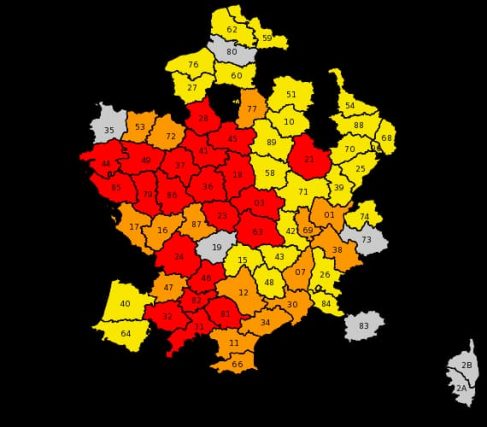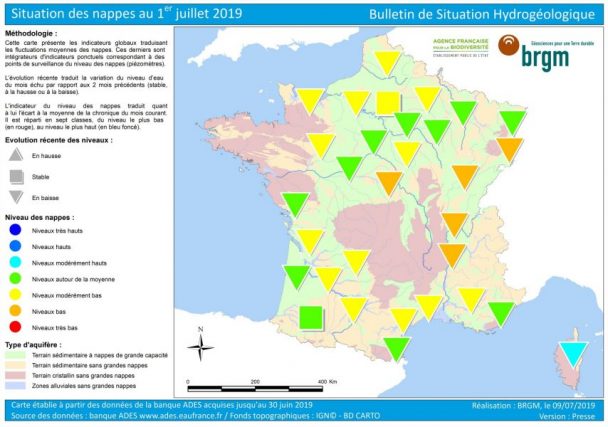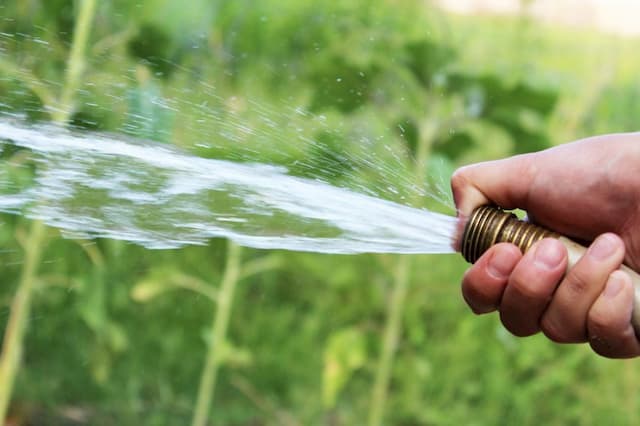In total, 121 orders to force individuals and professionals to save water. These water restrictions are due to continue until the end of the summer as the drought spreads
Sun and heat. Summer weather delights tourists and traders. But the lack of rain for several weeks is also and above all a source of concern in certain regions. And this drought continues to spread.
Wednesday 17th July 2019, 64 departments are indeed affected by water restriction measures according to the government site Propluvia
21 departments in “crisis”
Among them, 21 are even in a situation of “crisis” (in red on the map): Allier, Cher, Côte-d’Or, Creuse, Deux-Sèvres, Dordogne, Eure-et -Loir, Gers, Haute-Garonne, Indre, Indre-et-Loire, Loire-Atlantique, Loir-et-Cher, Loiret, Lot, Maine-et-Loire, Puy -de-Dôme, Tarn, Tarn-et-Garonne, Vendée and Vienne.
“Only levies to ensure the exercise of priority uses are authorized (health, civil security, drinking water, sanitation). “
In these regions, individuals and professionals are subject to drastic measures at the departmental level, specify in a map of the ministries of the Ecological Transition and Solidarity and Agriculture and Food.
In Vienne for example, the filling of existing pools is prohibited. As water withdrawals for watering vegetable gardens, from 9h to 19h each day. In the Tarn, pumping in some rivers and aquifers has been limited.
121 orders made by the prefects
16 departments are also placed on enhanced alert (in orange): Ain, Ardèche, Aveyron, Aude, Charente, Charente-Maritime, Gard, Haute-Vienne, Hérault, Isère, Lot-et-Garonne, Mayenne, Pyrénées-Orientales, Rhône, Sarthe and Seine-et-Marne.
Here are the steps that can be taken:
- reduction of levies for agricultural purposes greater than or equal to 50% (or prohibition of 3.5 days or more per week)
- greater limitation of levies for watering gardens, green spaces, golf courses, washing cars, …, until the prohibition of certain levies.

There are also 27 departments on alert with less restrictive measures (in yellow): Aube, Cantal, Doubs, Drôme, Eure, Haut-Rhin, Haute-Loire, Haute-Saone, Jura, Landes, Loire, Lozere, Marne, Meurthe-et-Moselle, Nièvre, Nord, Oise, Pas-de-Calais, Pyrénées-Atlantiques, Seine-Maritime, Saone-et-Loire, Territoire de Belfort, Val-de-Marne, Vosges, Yonne, Haute -Savoie and the Vaucluse.
For these other departments, specific measures are also in progress:
- reduction of agricultural levies below 50% (or ban up to three days a week)
- Valve Prohibition Measures, Water Activity
- prohibition at certain times of watering the gardens, green spaces, golfs, to wash his car …
For example, in the Lot-et-Garonne (orange) some samples for irrigation purposes were suspended several days a week. The inhabitants of Eure (in yellow) have no longer the right to water their lawn between 10am and 8pm, every day.
A total of 121 orders have been issued and are in progress (to encourage or oblige professionals and individuals to save water.) To find out what restrictive measures are taken near you, consult the website of your prefecture.
Deficit surface water
After the dog days of the end of June, “rainfall was almost absent on the northern half” of the 1 st to 10 July while rainfall activities episodes watered regions extending from the Pyrenees to the south of the Massif Central as well as locally in the Provence-Alpes-Côte d’Azur region and on the north of the Ile de Beauté, ” reports Météo France .
As a consequence, the drying of surface soils (surface water and streams). The trend is not expected to reverse because the institute is planning a hot and dry summer until September.
Depuis juillet 2018, la pluviométrie sur la France est marquée par un déficit qui perdure notamment sur les régions du Grand-Est et en Auvergne. Les sols superficiels sont très secs sur un large quart nord-est et les régions près de la Méditerranée. 👉https://t.co/PwXSO5VtJz pic.twitter.com/SHk8RSa4x9
— Météo-France (@meteofrance) 12 July 2019
A scarce recharge this winter in the groundwater
Groundwater levels, however, remain “around or below the average levels of June,” said the Bureau of Geological and Mining Research (BRGM) in its latest bulletin .
The hydrogeologist Laurence Gourcy, makes this observation:
“These levels reflect a scarce 2018-2019 recharge, due to low and sometimes late precipitation during autumn and winter.”

“However, the situation is better than in winter 2016-2017, which was not very humid. Almost all of France had been affected by the drought and the groundwater was in worse condition at the same time, “she tempers.
68% of drinking water consumption in the country comes from groundwater with 5.3 billion m 3 taken per year. Are feeding difficulties to be expected? “There may be local supply problems,” says Laurence Gourcy, but the connection of the networks makes it possible to compensate for a possible shortage. ”
Water restriction measures are more restrictive for the agricultural sector (2.78 billion m 3 taken from groundwater per year, Editor’s note), particularly among grain farmers and market gardeners. A challenge he has faced for several years.
The BRGM is doing its part: in 2018, it continued to publish its notes on the state of groundwater until October. An unprecedented measure linked to the late arrival of rains in autumn.



